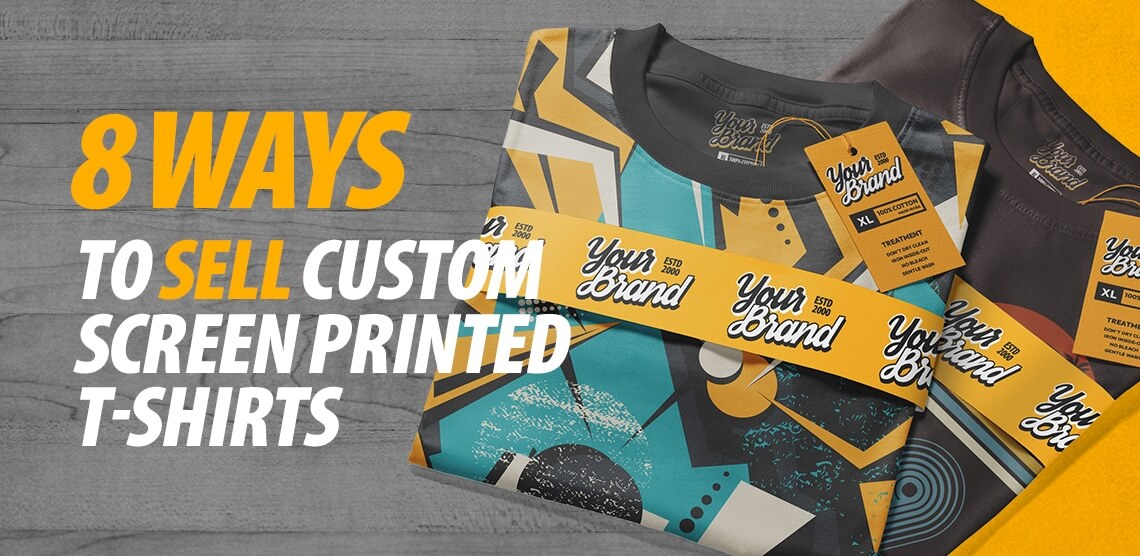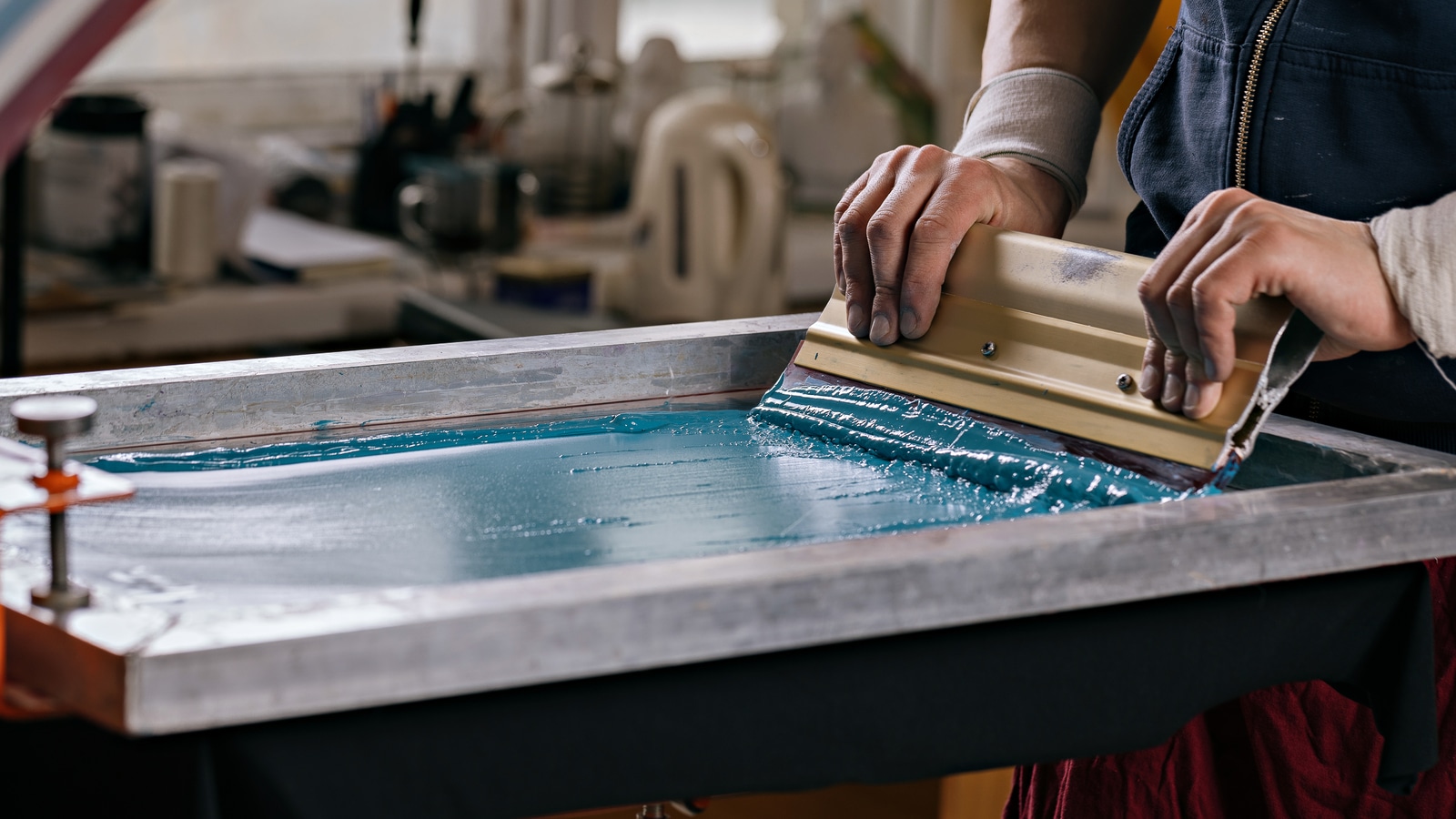Affordable Custom Screen Printing Services for Small Businesses
Affordable Custom Screen Printing Services for Small Businesses
Blog Article
Display Printing Uncovered: Everything You Need to Understand About Tee Shirt and Garment Printing Strategies
If you have actually ever asked yourself how those vibrant layouts wind up on your preferred t-shirts, you remain in the ideal area. Screen printing is an interesting technique that incorporates art with strategy, using countless opportunities for imagination. Understanding the basics, from equipment to ink selections, can substantially affect your outcomes. All set to discover the crucial aspects that make display printing an art form? Let's discover the details that can boost your projects.
The Basics of Screen Printing: Exactly How It Functions
When you plunge right into screen printing, you'll find it's both a scientific research and an art. At its core, display printing includes developing a stencil, or display, that enables ink to go through only in certain areas (screen printing kit). You begin by picking your style and preparing your display with a light-sensitive solution. When you subject this emulsion to light, it sets, leaving your design as a negative room.
Next, you'll blend your inks and prepare your printing surface area. Position the screen over the textile, after that use a squeegee to push ink through the screen onto the garment. This process needs precision, as you want clear, vivid prints. After printing, you'll cure the ink with warm, ensuring it abides by the textile and lasts with cleans. Each action is essential, and understanding them will certainly boost your screen printing skills, transforming straightforward garments right into distinct, expressive items.
Kinds of Screen Printing Techniques
When you comprehend the basics of screen printing, it's time to explore the numerous techniques that can elevate your designs. One prominent method is traditional display printing, where ink is pressed through a stenciled screen. This strategy is excellent for vibrant, vivid shades. After that there's water-based ink printing, which supplies a softer feeling and is environmentally friendly, however it needs a different technique to treating.
One more option is plastisol printing, understood for its resilience and vibrant colors, making it a favored for several brands. Experiment with halftone printing to create gradient impacts and elaborate designs.
Important Tools for Display Printing
To attain sensational results in screen printing, having the appropriate equipment is basic. Initially, you'll require a durable display printing framework, which holds the mesh that transfers your design onto the garment. Next off, invest in top notch mops; these are important for using ink evenly throughout the display. You'll likewise require a great direct exposure system to produce your displays, in addition to a washout cubicle for cleaning them after use. A reliable heat resource, like a conveyor clothes dryer or warmth press, is critical for healing your prints to guarantee longevity. Don't fail to remember a proper work space, geared up with tables and storage for your supplies. Ultimately, safety equipment, such as masks and gloves, will keep you risk-free from chemicals and inks. With the right tools, you'll be well on your method to producing professional-quality prints.
Picking the Right Inks and Products
When choosing inks and products for screen printing, you need to think about the sort of ink that functions ideal for your job. Consider material compatibility to ensure your designs look fantastic and last lengthy. Also, check out eco-friendly ink choices to make your printing process extra sustainable.
Sorts Of Screen Inks
Selecting the right display ink is essential for attaining vibrant, sturdy prints that fulfill your job's requirements. There are numerous kinds of display inks to check out. Specialty inks, such as glow-in-the-dark or metal, can include special impacts to your layouts.

Textile Compatibility Considerations
Recognizing material compatibility is vital for accomplishing premium screen prints, specifically since various materials respond distinctively to numerous inks. When choosing inks, take into consideration the fabric kind-- cotton, polyester, or blends. For cotton, water-based inks function well, supplying soft qualities and breathability. Polyester, on the various other hand, commonly requires plastisol inks for much better bond and dynamic shades. If you're publishing on blends, you might need to make use of a combination of both kinds. Always test your inks on example fabric to assure they stick effectively and keep color stability. Furthermore, remember that fabric weight and texture can affect the final outcome, so picking the ideal ink and product combination is vital for your task's success.
Eco-Friendly Ink Options
Green inks are coming to be a preferred option for display printers who desire to reduce their ecological effect while maintaining quality. When picking inks, think about water-based inks, which are less damaging and much easier to clean up contrasted to traditional solvents. These inks bond well with materials, supplying lively outcomes without hazardous chemicals. You could also check out eco-solvent inks that utilize less volatile natural substances (VOCs), making them a more secure option for both your health and the planet.
In addition, try to find inks made from eco-friendly resources, such as soy or vegetable-based choices. By picking the appropriate inks and materials, you'll not just create magnificent designs however additionally add to a much more sustainable printing procedure. Make the button, and your prints will show your dedication to the atmosphere!
Preparing Your Layout for Screen Printing

File Style Requirements
To assure your style looks lively and sharp on textile, you'll need to pay close focus to submit style needs for screen printing. Make certain your style has a clear history to stop undesirable white edges on your prints. Keep color modes in mind; CMYK is typical for display printing, so convert your RGB makes accordingly.
Shade Separation Methods
Shade separation is an essential action in preparing your layout for display printing, and grasping it can significantly boost your print quality. You'll need to break your design into private colors, as each color needs a different screen during printing. Beginning by identifying all the shades in your layout and create layers for each one. You can use software application like Adobe Photoshop or Illustrator to separate and different colors successfully. Be specific to conserve each layer as a different file, generally in a format like TIFF or PSD. This accuracy not just guarantees accurate shade depiction yet also simplifies the printing procedure. By taking notice of shade separation, you'll achieve specialist and vivid outcomes in your screen-printed garments.
Resolution and Size
Achieving the best lead to screen printing starts with assuring your layout has the ideal resolution and size. Preferably, your artwork should be at the very go to my site least 300 DPI (dots per inch) for sharp, clear prints. Your last product may look unprofessional and pixelated. if you utilize lower resolution.
When it concerns size, take into consideration the measurements of your print area. Design your art work to match the last print dimension, ideally producing it in the actual measurements you'll be printing. By doing this, you'll stay clear of any unanticipated scaling problems.
Always examine your design in both vector and raster formats. Vector graphics can be scaled without losing quality, making them perfect for display printing. Preparing appropriately will guarantee your design looks fantastic on every garment!
Step-by-Step Display Printing Refine
Display printing is a vibrant process that allows you to create lively designs on various surfaces. To get started, you'll need a screen, emulsion, and your chosen ink. Prepare your screen by cleansing it thoroughly. Next, apply the emulsion equally and allow it completely dry in a dark area. When completely dry, expose your display to light with your style put on it, which will certainly harden the emulsion where the light hits, developing a stencil - screen printing kit.
Pour ink onto the screen and make use of a squeegee to push the ink through the pattern onto the material. Raise the display very carefully and let the print completely dry. You've efficiently display printed your design.
Tips for Effective Display Printing Projects
While you're diving right into your display printing jobs, remember that preparation is essential to success. Start by gathering all your materials-- inks, displays, mops, and garments. A tidy workspace assists protect against unwanted errors, so clean up before you begin.
Following, verify your artwork is high-resolution and effectively sized for your garment. Examine your screen for correct direct exposure and clean it completely to avoid spots. When mixing your inks, adhere to the manufacturer's standards to achieve the right uniformity.
Throughout printing, use even pressure with your squeegee for regular results. Do not hurry; take your time to verify each print satisfies your requirements. After printing, let your garments dry totally before managing or packaging them.
Finally, always maintain an example of your benefit future reference. By doing this, you can analyze your progress and improve your strategies gradually. Satisfied printing!

Regularly Asked Questions
How Lengthy Does It Take to Establish up a Screen Printing Work?
Establishing up a display printing work normally takes around thirty minutes to an hour. You'll prepare the displays, mix inks, and adjust the press. The moment differs based use this link on intricacy and experience, so remain organized!
Can I Print on Various Material Types Making Use Of the Exact Same Strategy?
Yes, you can publish on different material kinds making use of the exact same strategy, but you'll need to adjust your setups and inks. Some textiles soak up ink in different ways, so experimenting guarantees the most effective outcomes for each and every material.
What Are Usual Errors to Prevent in Display Printing?
When screen printing, avoid typical errors like using the wrong ink, disregarding appropriate exposure times, or skipping pre-press checks. Constantly examine your arrangement and keep clean displays to guarantee quality results each time.
Exactly How Can I Effectively Clean and Keep My Screen Printing Devices?
To correctly clean and keep your display printing devices, you should regularly clean screens with proper solvents, examine mops for wear, and ensure all devices are saved completely dry and dust-free. Uniformity boosts and prevents expensive repair services efficiency.
Is Display Printing Environmentally Friendly Compared to Other Methods?
Screen printing can be a lot more environmentally pleasant than various other techniques, especially if you use water-based inks and eco-conscious products. By selecting sustainable materials and methods, you minimize waste and reduce your influence on the world.
Screen Printing Uncovered: Everything You Need to Know Regarding T-Shirt and Garment Printing Strategies
At its core, display printing entails creating a stencil, or display, that enables ink to pass with only in certain areas. Position the display over the textile, then use a squeegee to press ink via the display onto the garment. One preferred approach is conventional screen printing, where ink is pressed with a stenciled display.When selecting inks and products for screen printing, you need to take right into account the kind of ink that works finest for your project.
Report this page